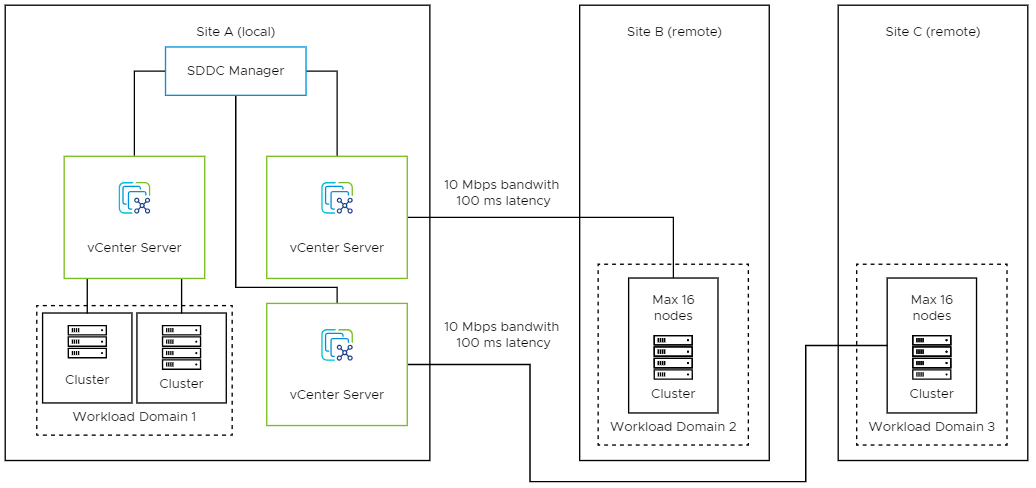With VMware Cloud Foundation Remote Clusters, you can deploy a VI workload domain that has its vSphere cluster at a remote location. You can also enable VMware Cloud Foundation with Tanzu on a cluster deployed at a remote site. Remote clusters are managed by the VMware Cloud Foundation instance at the central site. You can perform a full-stack life cycle management for the remote sites from the central SDDC Manager UI.
VMware Cloud Foundation Remote Clusters have the following limitations:

- VMware Cloud Foundation supports up to 8 VI workload domains with a single remote cluster each.
- Each remote cluster can have up to 16 hosts.
- A VI workload domain can include local clusters or a remote cluster, but not both.

The prerequisites for deploying a VI workload domain with a remote cluster are:
- Ensure that you meet the general prerequisites for deploying a VI workload domain. See Prerequisites for a Workload Domain.
- VMware Cloud Foundation Remote Clusters supports a minimum of 3 and maximum of 16 hosts. For information on principal and supplemental storage on hosts, see Managing Storage in VMware Cloud Foundation.
Note: If you are using NFS, VMFS on FC, or vVols as principal storage, and the VI workload domain is using vSphere Lifecycle Manager images as the update method, then only two hosts are required. Workload Management requires a vSphere cluster with a minimum of three ESXi hosts.
- Dedicated WAN connectivity is required between central site and VMware Cloud Foundation Remote Clusters site.
- Primary and secondary active WAN links are recommended for connectivity from the central site to the VMware Cloud Foundation Remote Clusters site. The absence of WAN links can lead to two-failure states, WAN link failure, or NSX Edge node failure, which can result in unrecoverable VMs and application failure at the VMware Cloud Foundation Remote Clusters site.
- Minimum bandwidth of 10 Mbps and latency of 100 ms is required between the central VMware Cloud Foundation instance and VMware Cloud Foundation Remote Clusters site.
- The network at the VMware Cloud Foundation Remote Clusters site must be able to reach the management network at the central site.
- DNS and NTP server must be available locally at or reachable from the VMware Cloud Foundation Remote Clusters site
For information on enabling VMware Cloud Foundation with Tanzu on a cluster deployed at a remote site, see VMware Cloud Foundation with VMware Tanzu.